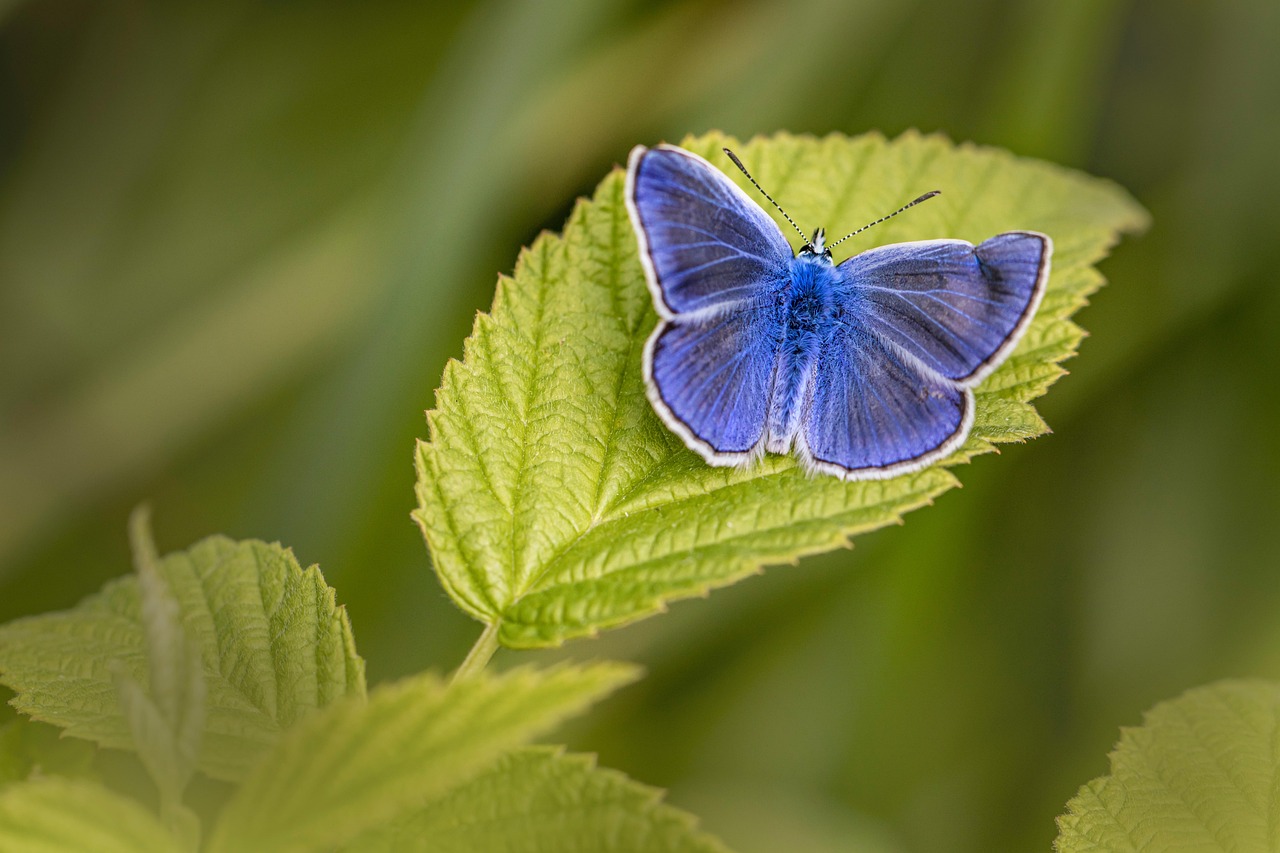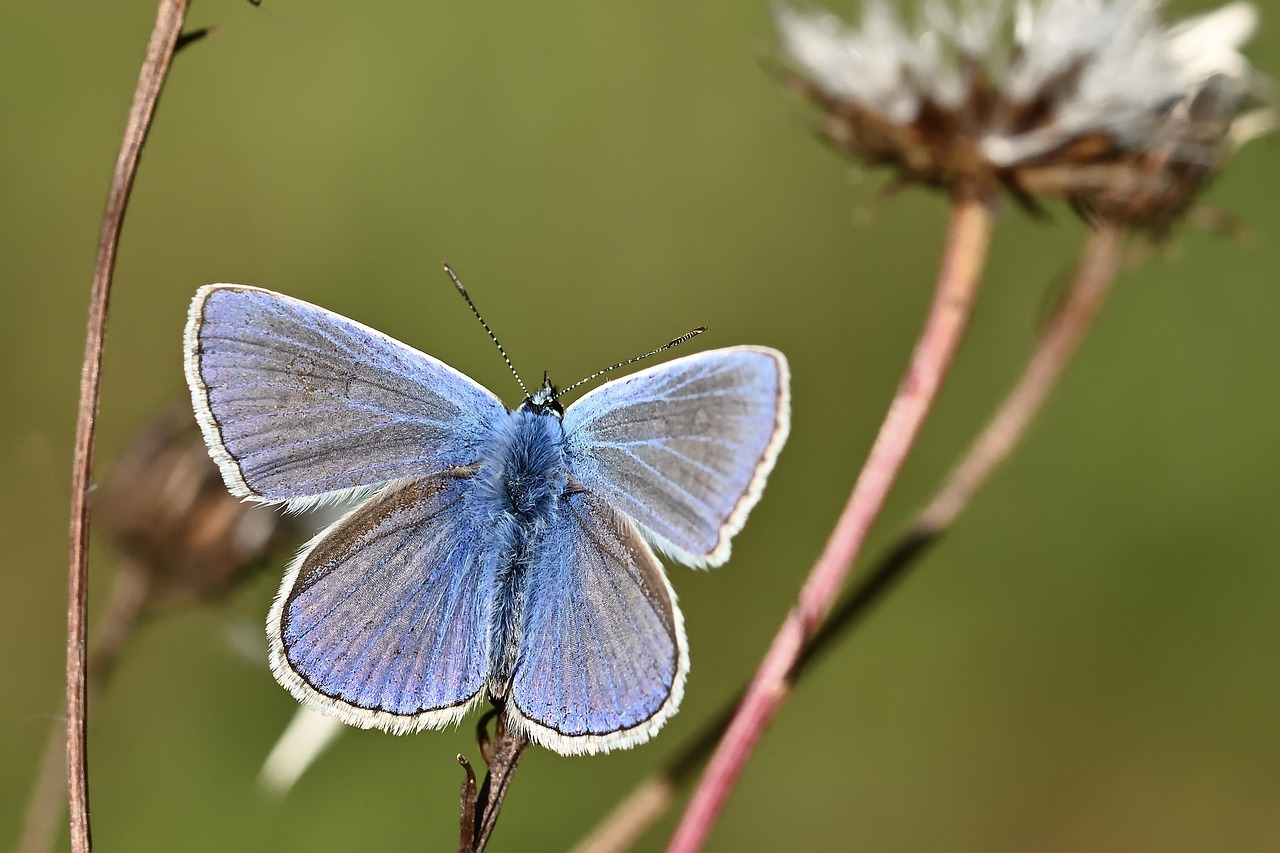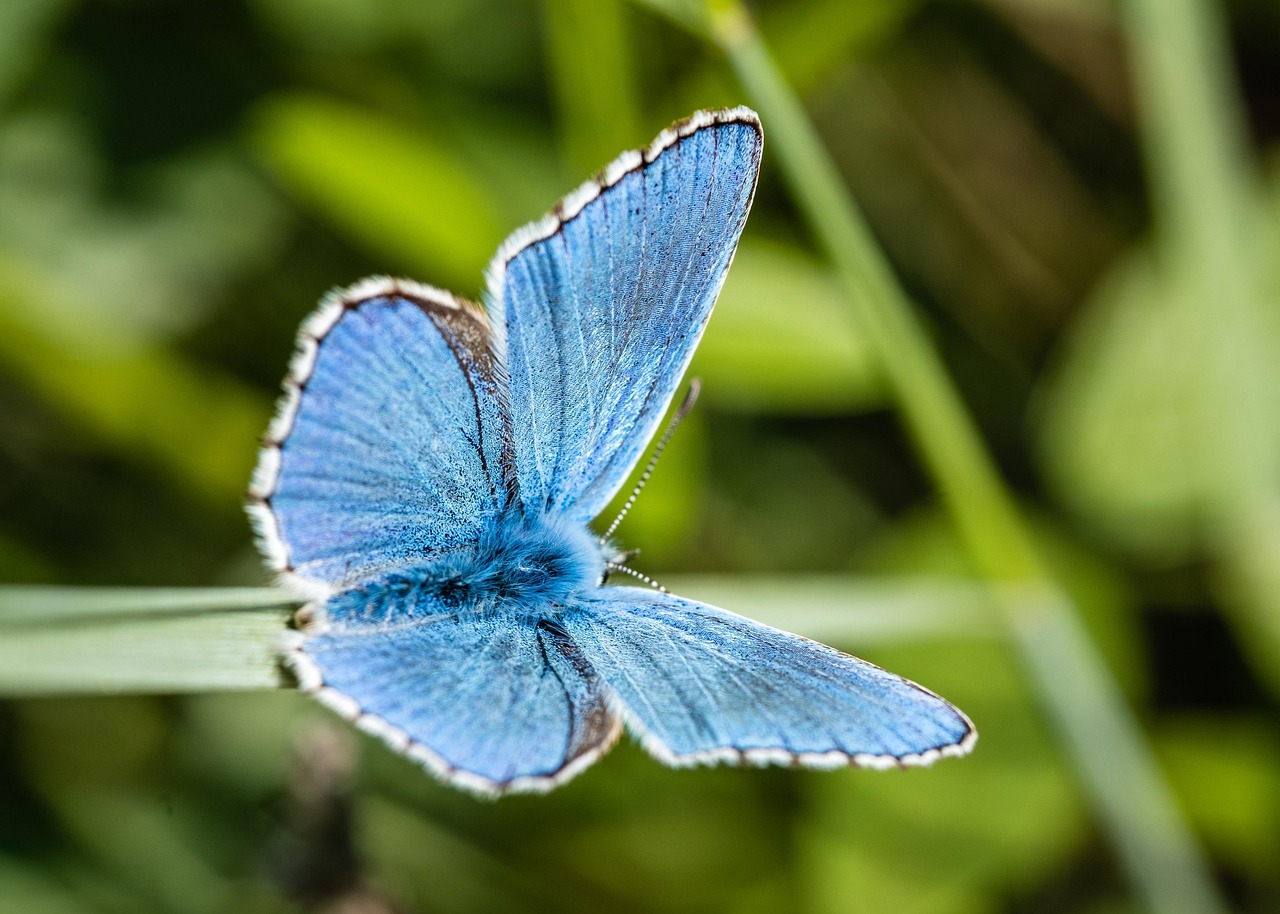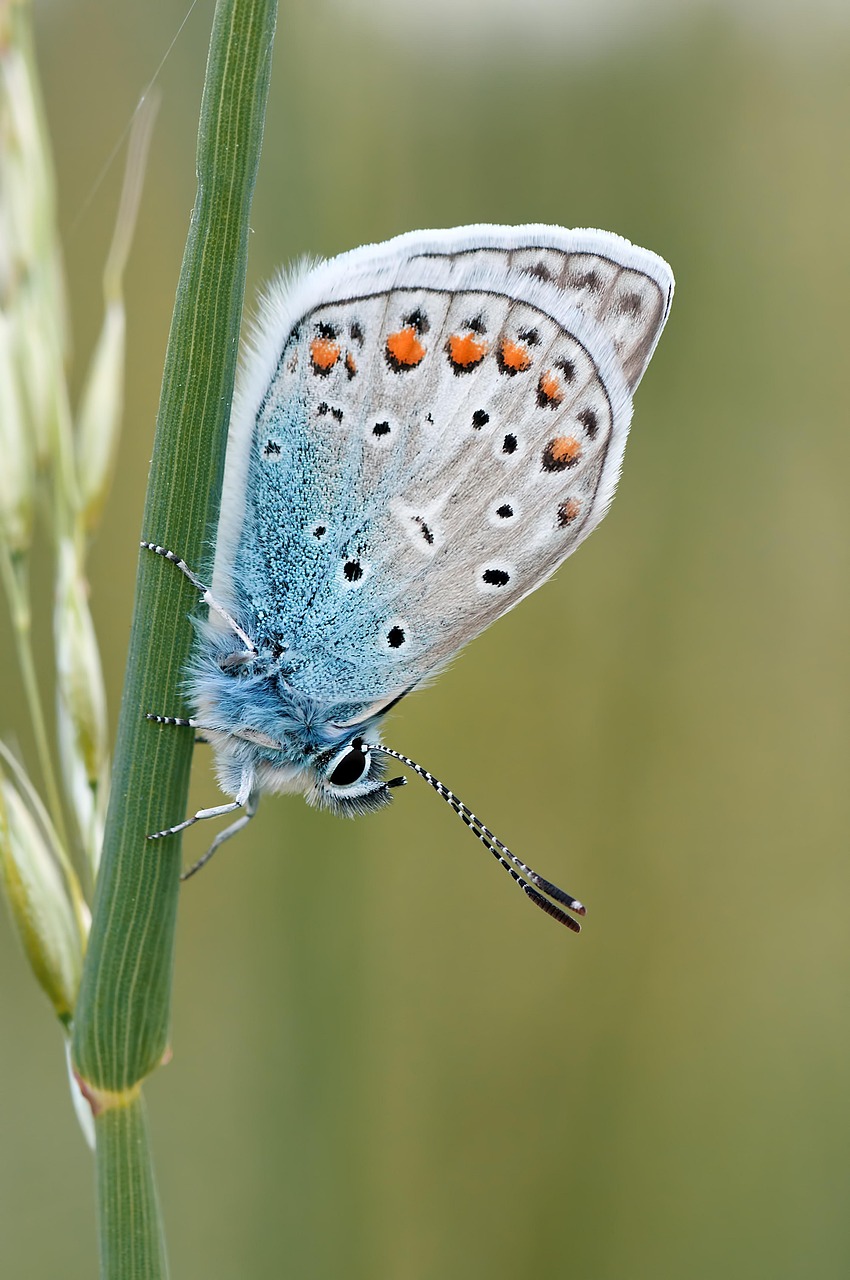The Karner Blue Butterfly is highly dependent on its specific biome, particularly oak savannas and dry prairies. These habitats provide the necessary resources, such as food plants like wild lupine for larvae and open areas for adult butterflies to thrive. Without these ecosystems, the butterfly’s survival is jeopardized.
Understanding the Karner Blue Butterfly

The Karner Blue Butterfly (Plebejus melissa samuelis) is a small yet striking species that has captured the attention of ecologists and conservationists alike. This butterfly is native to North America and primarily found in the northeastern United States and parts of Canada. It is known for its vibrant blue wings, which can vary in shades depending on the gender and environmental factors.
One of the most defining features of the Karner Blue Butterfly is its unique life cycle, which is intricately linked to its biome. The butterfly undergoes complete metamorphosis, transitioning from egg to larva (caterpillar) to pupa (chrysalis) and finally to adult. Each stage of this life cycle is directly influenced by the availability of specific plants and environmental conditions.
The Importance of Biomes
Biomes are large ecological areas on the Earth’s surface, characterized by specific climates, flora, and fauna. The Karner Blue Butterfly thrives in particular biomes, most notably oak savannas and dry prairies, which provide essential resources for its survival.
These ecosystems are not only home to the butterfly but also host a variety of other species that contribute to their biodiversity. The interdependence of species within these biomes reinforces the delicate balance of nature. When one species, such as the Karner Blue Butterfly, is affected, it can have a cascading effect on the entire ecosystem.
Key Habitat Characteristics
The habitats favored by the Karner Blue Butterfly possess specific characteristics that are crucial for its life cycle:
- Soil Type: Sandy soils allow for optimal drainage, which is essential for the growth of wild lupine.
- Plant Diversity: A rich variety of plant species helps support both the butterfly and other wildlife in the area.
- Sunlight Exposure: Open fields with full sunlight are necessary for adults to warm their wings and engage in mating behaviors.
- Minimal Vegetation: Sparse vegetation prevents competition for resources and makes it easier for butterflies to navigate their environment.
Threats to the Biome
Despite its reliance on these specific habitats, the Karner Blue Butterfly faces numerous threats that jeopardize its existence. Habitat loss due to urban development, agriculture, and invasive species has significantly reduced its populations. Additionally, climate change poses a risk by altering temperature and precipitation patterns, further affecting the delicate balance of its biome.
Conservation efforts are critical in preserving these unique ecosystems. Protecting existing habitats and restoring degraded areas can help ensure the survival of the Karner Blue Butterfly and other species that share its biome. In many regions, local organizations and government agencies are actively working to create protected areas and promote sustainable land use practices.
Conclusion on Conservation Efforts
The interplay between the Karner Blue Butterfly and its biome illustrates the importance of preserving natural habitats. As we learn more about this butterfly’s dependence on specific environmental conditions, it becomes increasingly clear that protecting these ecosystems is vital not only for the butterfly but also for maintaining biodiversity as a whole.
Life Cycle of the Karner Blue Butterfly
The life cycle of the Karner Blue Butterfly is a fascinating journey that highlights its dependence on specific environmental conditions and resources. Understanding this cycle is crucial for conservation efforts aimed at protecting the species.
Stages of Development
The life cycle consists of four main stages: egg, larva, pupa, and adult. Each stage has distinct requirements and challenges:
- Egg: The female butterfly lays eggs on the leaves of wild lupine plants. This plant is essential as it serves as the primary food source for the caterpillars once they hatch.
- Larva (Caterpillar): After about a week, the eggs hatch into small caterpillars. The larvae feed voraciously on the lupine leaves, growing rapidly. This stage lasts approximately two to three weeks.
- Pupa (Chrysalis): Once mature, the caterpillars form a chrysalis. This transformative phase can last from one to two weeks, during which the caterpillar undergoes metamorphosis.
- Adult Butterfly: The adult emerges from the chrysalis. Initially, its wings are crumpled and wet, requiring sunlight to dry and expand before it can fly.
Seasonal Patterns
The Karner Blue Butterfly has a seasonal life cycle, which is closely tied to its habitat’s climate. In most regions, they typically have one generation per year. The timing of each life stage is critical for survival:
- Eggs: Laid in late spring, they require warm temperatures to develop properly.
- Larvae: Active during the summer months when wild lupine is abundant. This is when they face threats from predators and adverse weather.
- Pupation: Occurs by late summer, allowing them to prepare for winter.
- Emergence: The adults emerge in late spring of the following year, syncing with the blooming of wild lupine.
Feeding Habits and Habitat Interaction

The feeding habits of the Karner Blue Butterfly are vital for its growth and development. During the larval stage, the caterpillars exclusively consume wild lupine leaves. This dependence on a single plant species underscores the importance of maintaining healthy populations of lupine within their biome.
Role of Wild Lupine
Wild lupine (Lupinus perennis) is not only a food source but also plays a critical role in the ecosystem that supports the Karner Blue Butterfly:
- Nutritional Value: The leaves of wild lupine provide essential nutrients for larval growth.
- Habitat Creation: These plants help create open areas that are crucial for adult butterflies to bask in sunlight.
- Symbiotic Relationships: Wild lupine supports other species within the ecosystem, enhancing biodiversity.
Interactions with Other Species
The Karner Blue Butterfly does not exist in isolation. Its interactions with other species play a significant role in its life cycle:
- Predators: Birds, spiders, and other insects prey on both caterpillars and adult butterflies, influencing population dynamics.
- Pollinators: Adult butterflies also contribute to pollination in their habitat. Their presence can enhance the reproductive success of various plant species.
- Competitors: The presence of invasive plant species can hinder the growth of wild lupine, thereby threatening the butterfly’s survival.
The interconnectedness between the Karner Blue Butterfly and its biome emphasizes the need for comprehensive conservation strategies. To protect this delicate balance, efforts must address not only the butterfly but also its food sources and habitat requirements.

Conservation Challenges and Strategies
As the Karner Blue Butterfly faces numerous challenges, understanding these threats is essential for developing effective conservation strategies. The pressures on its habitat and population require a multifaceted approach to ensure its survival.
Habitat Loss
One of the most significant threats to the Karner Blue Butterfly is habitat loss. Urban development, agriculture, and land conversion have led to the destruction of crucial ecosystems. The following factors contribute to habitat loss:
- Urbanization: Expansion of cities and towns often results in the clearance of natural habitats, disrupting local ecosystems.
- Agricultural Practices: Intensive farming techniques can lead to soil degradation and the removal of native plants, including wild lupine.
- Invasive Species: Non-native plants can outcompete wild lupine for resources, diminishing its availability for the butterfly.
Climate Change
Climate change poses another layer of risk to the Karner Blue Butterfly. Altered weather patterns and increased temperatures can significantly impact its life cycle and habitat. Key concerns include:
- Temperature Fluctuations: Warmer winters can disrupt the timing of life stages, impacting reproduction and survival rates.
- Altered Plant Growth: Changes in precipitation and temperature can affect the growth patterns of wild lupine, reducing food availability for larvae.
- Extreme Weather Events: Increased frequency of storms, droughts, and floods can destroy habitats and threaten butterfly populations.
Conservation Efforts
In response to these challenges, various conservation efforts have been implemented to protect the Karner Blue Butterfly and its habitats. These initiatives aim to restore ecosystems, promote sustainable practices, and engage local communities in conservation activities.
Protected Areas
Establishing protected areas is one of the most effective strategies for conserving the Karner Blue Butterfly. These areas provide safe habitats free from development and degradation. Important aspects of this strategy include:
- Designation of Habitats: Identifying and designating critical habitats as protected areas helps ensure the survival of both the butterfly and its food sources.
- Management Plans: Implementing management plans that focus on habitat restoration, invasive species control, and monitoring populations is essential for long-term success.
Community Involvement
Engaging local communities in conservation efforts is vital for fostering a sense of stewardship towards the environment. Strategies to involve communities include:
- Education Programs: Educating the public about the importance of the Karner Blue Butterfly and its habitat can encourage support for conservation initiatives.
- Volunteer Opportunities: Providing opportunities for individuals to participate in habitat restoration projects can increase community investment in local ecosystems.
- Collaboration with Landowners: Working with private landowners to promote sustainable land use practices helps protect habitats outside designated reserves.
Research and Monitoring

Ongoing research and monitoring are crucial to understanding the dynamics of the Karner Blue Butterfly populations. Scientific studies can inform conservation strategies by providing insights into:
- Population Trends: Monitoring population sizes and distribution helps identify areas where intervention is needed.
- Habitat Requirements: Researching specific habitat needs enables targeted conservation efforts that maximize effectiveness.
- Impact of Climate Change: Studying how climate change affects the butterfly’s life cycle informs adaptive management practices.
The integration of research findings into conservation policies ensures that strategies remain relevant and effective in addressing emerging challenges for the Karner Blue Butterfly and its biome.
Future Directions for Conservation
As we look to the future, several key areas must be addressed to enhance the conservation of the Karner Blue Butterfly and its biome. These areas include habitat restoration, legislative support, and public awareness campaigns.
Habitat Restoration Efforts
Restoring degraded habitats is a vital step in supporting the Karner Blue Butterfly population. Effective restoration efforts should focus on:
- Replanting Native Flora: Reintroducing wild lupine and other native plants can help restore the butterfly’s food source and improve habitat quality.
- Controlled Burns: Implementing controlled burns can help maintain open habitats that are essential for the butterfly’s lifecycle while reducing invasive species.
- Soil and Water Management: Improving soil health and managing water resources can create better conditions for native plant growth.
Legislative Support
Strong legislative frameworks are necessary for ongoing conservation efforts. Policymakers play a crucial role in ensuring that the needs of the Karner Blue Butterfly are considered in land use planning. Important legislative measures include:
- Endangered Species Protections: Ensuring that the Karner Blue Butterfly is listed under relevant endangered species acts can provide critical protections against habitat destruction.
- Funding for Conservation Programs: Allocating government funds for research, habitat restoration, and community education programs can significantly enhance conservation efforts.
- Land Use Regulations: Enforcing regulations that limit development in critical habitats helps maintain the ecological integrity necessary for the butterfly’s survival.
Public Awareness and Education
Raising public awareness about the Karner Blue Butterfly and its ecological role is essential for garnering support for conservation initiatives. Strategies to increase public engagement include:
- Community Workshops: Organizing workshops to educate community members about the importance of biodiversity and local ecosystems can foster a sense of responsibility.
- School Programs: Integrating butterfly conservation into school curricula can inspire younger generations to appreciate and protect their natural heritage.
- Social Media Campaigns: Utilizing social media platforms to share information about the butterfly’s plight can reach a wider audience and mobilize community support.
Conclusion
The Karner Blue Butterfly serves as a poignant reminder of the intricate connections within our ecosystems. Its dependence on specific biomes highlights the importance of preserving these habitats, not just for this species but for the overall health of our environment. The ongoing threats from habitat loss, climate change, and invasive species necessitate concerted conservation efforts.
By implementing effective habitat restoration projects, strengthening legislative protections, and fostering public engagement, we can create a sustainable future for the Karner Blue Butterfly. Each action taken today contributes to safeguarding this unique butterfly and promoting biodiversity for generations to come.
Ultimately, the fate of the Karner Blue Butterfly rests in our hands. Collective efforts towards education, legislation, and habitat protection can ensure that this beautiful species continues to thrive in its natural biome, enriching our ecosystems with its presence.
